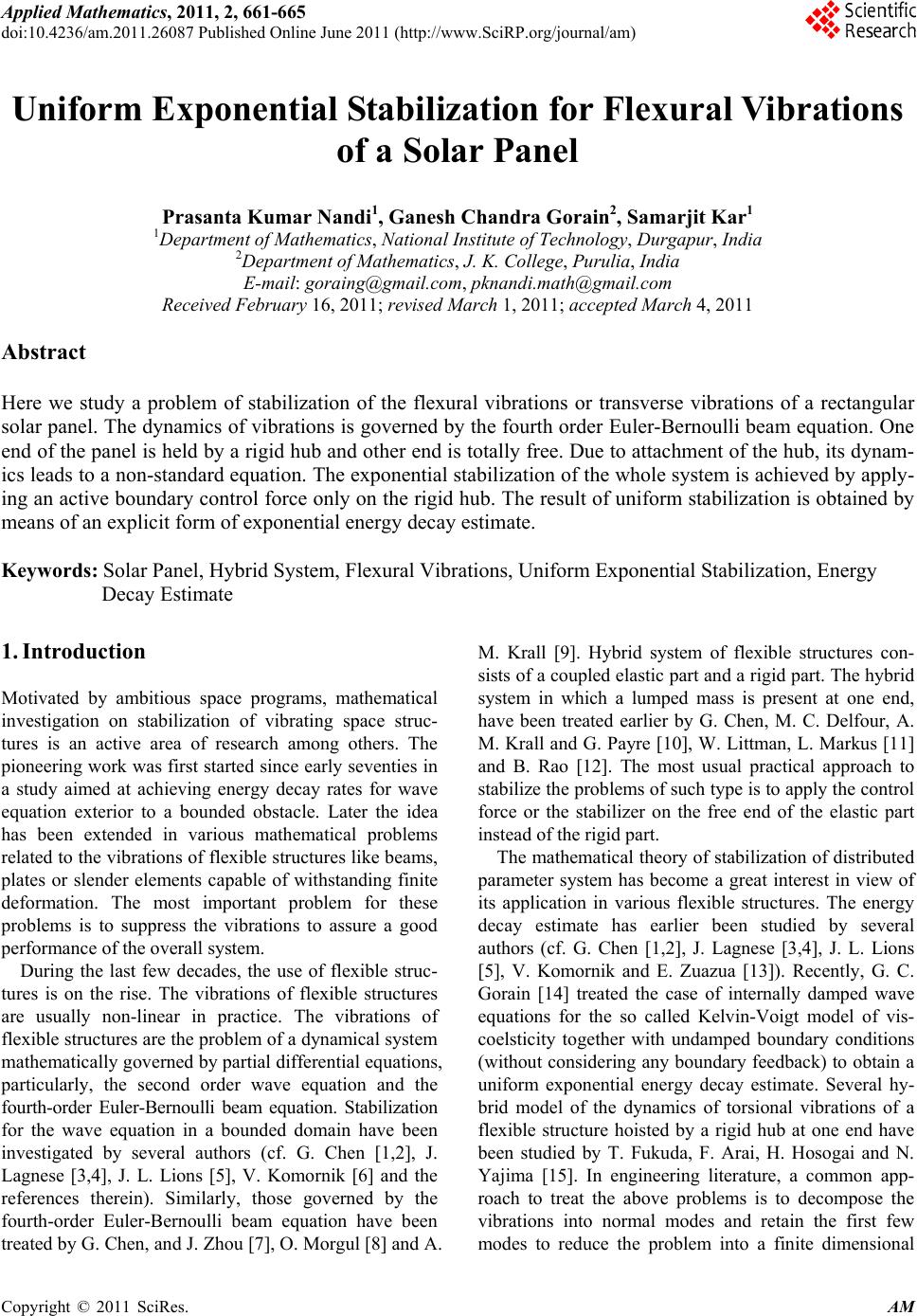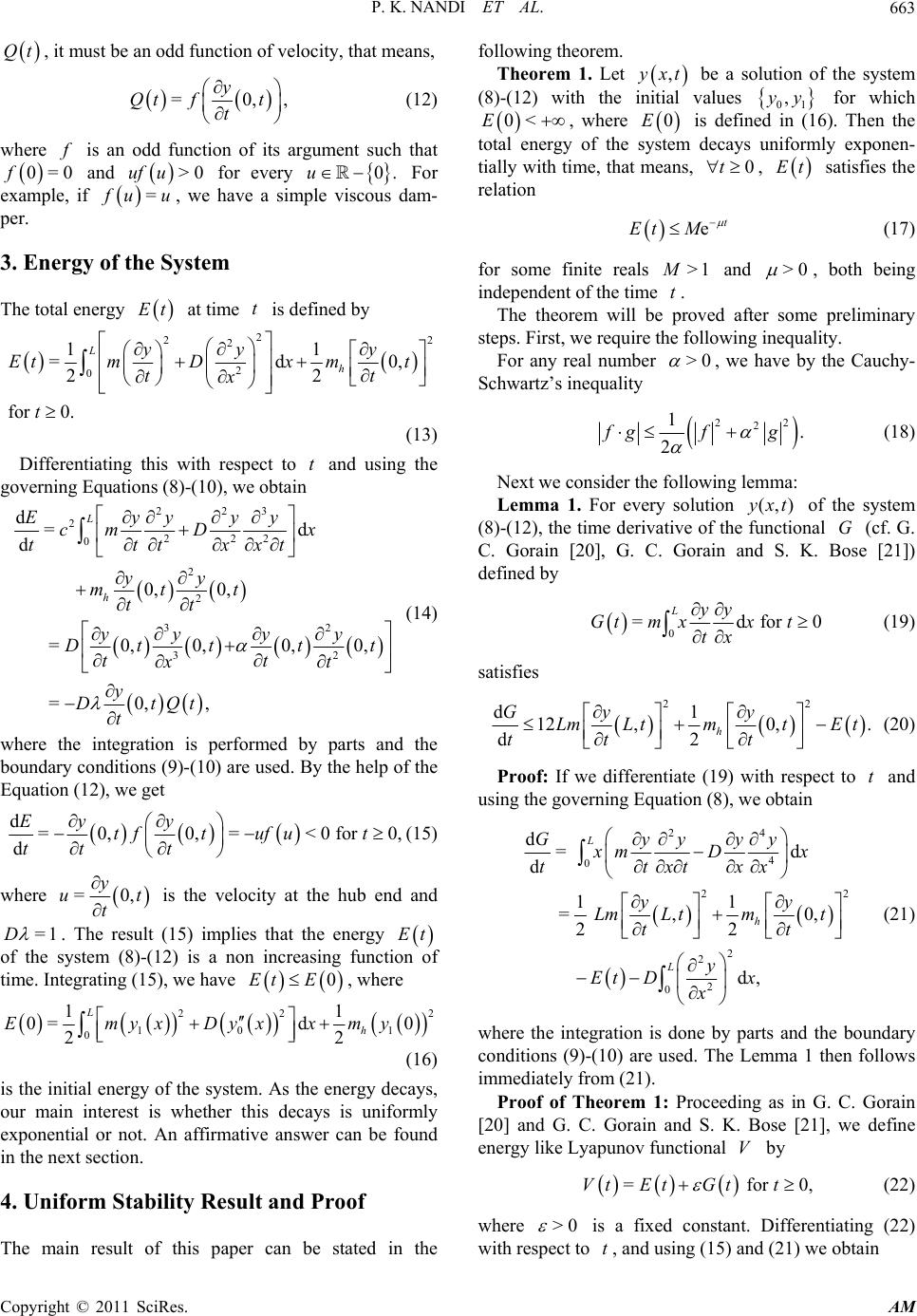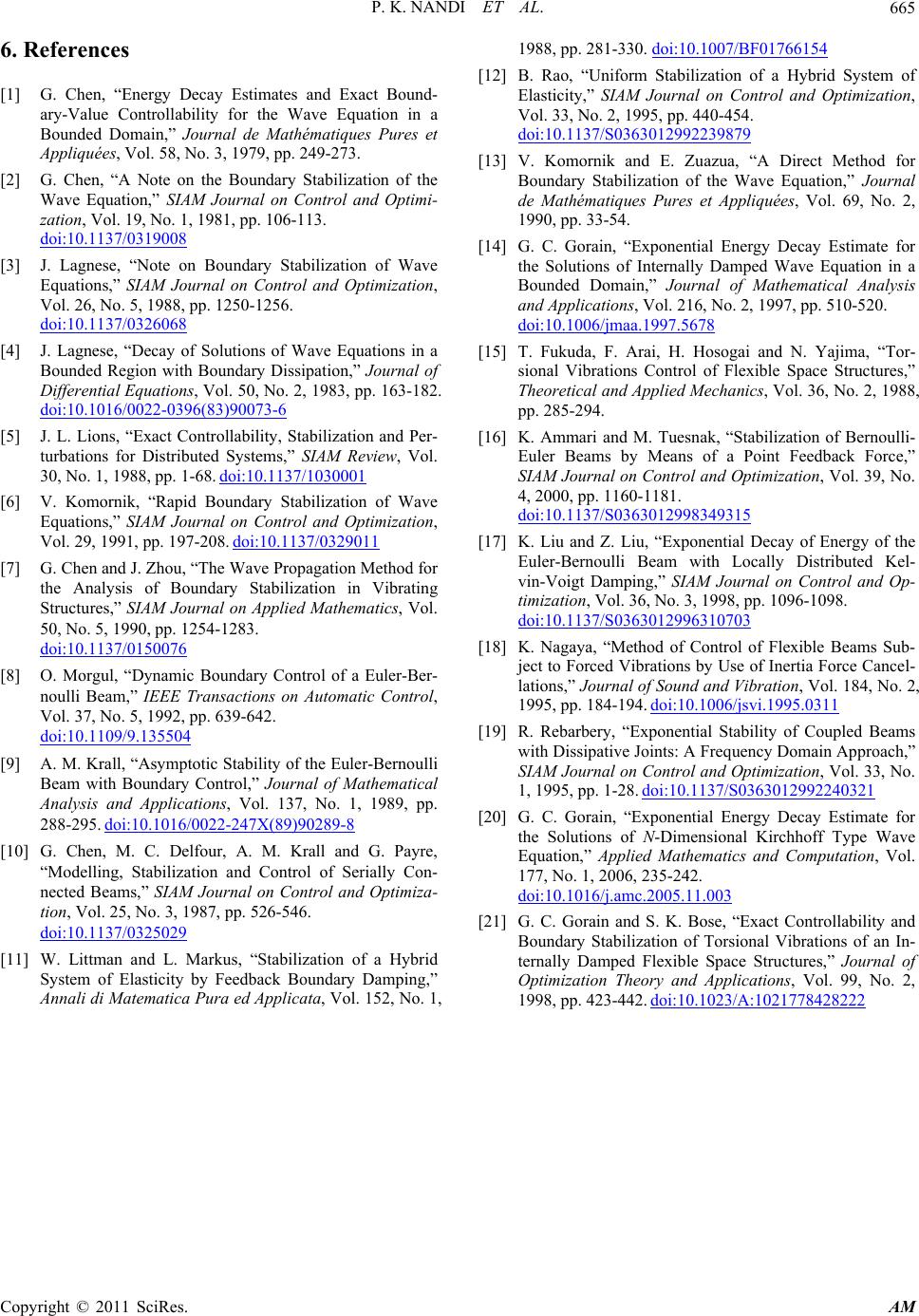 Applied Mathematics, 2011, 2, 661-665 doi:10.4236/am.2011.26087 Published Online June 2011 (http://www.SciRP.org/journal/am) Copyright © 2011 SciRes. AM Uniform Exponential Stabilization for Flexural Vibrations of a Solar Panel Prasanta Kumar Nandi1, Ganesh Chandra Gorain2, Samarjit Kar1 1Department of Mat hem at i cs, National Institute of Technology, Durgapur , India 2Department of Mat hem at i cs, J. K. College, Purulia, India E-mail: goraing@gmail.co m , pknandi.math@gmai l .co m Received February 16, 2011; re vi s ed M ar ch 1, 2011; accepted March 4, 2011 Abstract Here we study a problem of stabilization of the flexural vibrations or transverse vibrations of a rectangular solar panel. The dynamics of vibrations is governed by the fourth order Euler-Bernoulli beam equation. One end of the panel is held by a rigid hub and other end is totally free. Due to attachment of the hub, its dynam- ics leads to a non-standard equation. The exponential stabilization of the whole system is achieved by apply- ing an active boundary control force only on the rigid hub. The result of uniform stabilization is obtained by means of an explicit form of exponential energy decay estimate. Keywords: Solar Panel, Hybrid System, Flexural Vibrations, Uniform Exponential Stabilization, Energy Decay Estimate 1. Introduction Motivated by ambitious space programs, mathematical investigation on stabilization of vibrating space struc- tures is an active area of research among others. The pioneering work was first started since early seventies in a study aimed at achieving energy decay rates for wave equation exterior to a bounded obstacle. Later the idea has been extended in various mathematical problems related to the vibrations of flexible structures like beams, plates or slender elements capable of withstanding finite deformation. The most important problem for these problems is to suppress the vibrations to assure a good performance of the overall system. During the last few decades, the use of flexible struc- tures is on the rise. The vibrations of flexible structures are usually non-linear in practice. The vibrations of flexible structures are the problem of a dynamical system mathematically governed by partial differential equations, particularly, the second order wave equation and the fourth-order Euler-Bernoulli beam equation. Stabilization for the wave equation in a bounded domain have been investigated by several authors (cf. G. Chen [1,2], J. Lagnese [3,4], J. L. Lions [5], V. Komornik [6] and the references therein). Similarly, those governed by the fourth-order Euler-Bernoulli beam equation have been treated by G. Chen, and J. Zhou [7], O. Morgul [8] and A. M. Krall [9]. Hybrid system of flexible structures con- sists of a coupled elastic part and a rigid part. The hybrid system in which a lumped mass is present at one end, have been treated earlier by G. Chen, M. C. Delfour, A. M. Krall and G. Payre [10], W. Littman, L. Markus [11] and B. Rao [12]. The most usual practical approach to stabilize the problems of such type is to apply the control force or the stabilizer on the free end of the elastic part instead of the rigid part. The mathematical theory of stabilization of distributed parameter system has become a great interest in view of its application in various flexible structures. The energy decay estimate has earlier been studied by several authors (cf. G. Chen [1,2], J. Lagnese [3,4], J. L. Lions [5], V. Komornik and E. Zuazua [13]). Recently, G. C. Gorain [14] treated the case of internally damped wave equations for the so called Kelvin-Voigt model of vis- coelsticity together with undamped boundary conditions (without considering any boundary feedback) to obtain a uniform exponential energy decay estimate. Several hy- brid model of the dynamics of torsional vibrations of a flexible structure hoisted by a rigid hub at one end have been studied by T. Fukuda, F. Arai, H. Hosogai and N. Yajima [15]. In engineering literature, a common app- roach to treat the above problems is to decompose the vibrations into normal modes and retain the first few modes to reduce the problem into a finite dimensional  P. K. NANDI ET AL. 662 state space representation. The question of uniform stabilization or point-wise stabilization of Euler-Ber- noulli beams or serially connected beams has been stu- died by a number of authors (cf. J. L. Lions [5], G. Chen, M. C. Delfour, A. M. Krall and G. Payre [10], K. Ammari and M. Tuesnak [16], K. Liu and Z. Liu [17], K. Nagaya [18], R. Rebarbery [19] etc.). 2. Mathematical Formulation of the Problem We consider a uniform rectangular flexible solar panel hoisted by a rigid hub at one end. The panel is of length , unit width, having uniform mass density per unit length, which is rigidly attached by a lumped mass h (hub) at one end and that is totally free at the other end. Our aim is to stabilize the vibrations of the overall system by applying a suitable stabilizer or damper on the rigid hub, when it is initially set in motion. Lmm Referring to the schematic Figure 1, if h t is the transverse displacement of the rigid hub and , p xt is that of the panel at the position along the span of the panel relative to the hub at time , then the total trans- verse deflection can be written as t ,=,, 0, 0. hp yxty tyxtxLt (1) Let us assume that the vibrations undergo only small deformations, that means, ,yxt L and , yxt x 1, and neglect the gravitational effect and rotatory inertia of the panel cross sections. Then , xt satisfies fourth order Euler-Bernoulli beam equation 24 24 ,,=0, 0, yy mxtDxt xLt tx 0, (2) where 1 32 11 12 DEh . The constants , , DE and are the flexural rigidity, the Youngs’s modulus, the Poisson’s ratio and the thickness of the panel respectively. h The dynamics at the hub end , where a control force is applied, yields the differential equation =0x Qt 3 2 23 0,=0, 0. p h h y y mtD tQtt tx (3) The Equation (3) is not a standard Dirichlet or Neu- mann boundary condition, that is generally found in the several works of this subject area. Again since 0, 0 p yt, it follows from (1) that 0,=h tyt and also we have ,= , p y y t xx xt . Hence the Equa- tion (3) becomes Figure 1. Schematic of the solar pane l wi th rigid hub. 32 32 0,0,=0, 0, yy ttQt xt t (4) where =h m D and 1 =D . Assuming at , there =0x is no rotational deflection of the panel relative to the hub (that means, the panel is built in position with hub at =0x), we have 0,=0 p yt x , implying 0,=0, 0. ytt x (5) Since the panel is assumed to be free at = L, so at this end 23 23 ,=0 and ,=0, 0, yy LtLt t xx (6) Let the panel be set to vibrations with arbitrary initial values 01 ,0= and ,0=, 0. y yx yxx yxxL t (7) Therefore, the mathematical model to be studied for flexural or transverse vibrations of a uniform rectangular flexible solar panel with a rigid hub at one end, is go- verned by the following system of equations : 24 24 ,,=0, 0, yy mxtDxt xLt tx 0, (8) 32 32 0,0,= 0 and 0,=0, yy y ttQt t x xt (9) 23 23 ,=0 and ,=0, 0, yy LtLt t xx (10) 01 ,0= and,0=, 0. y yx yxx yxxL t (11) Because of the damping character of the control force Copyright © 2011 SciRes. AM  P. K. NANDI ET AL.663 Qt, it must be an odd function of velocity, that means, =0, y Qt ft t , (12) where is an odd function of its argument such that and for every 0=f0 >0uf u 0.u For example, if = uu, we have a simple viscous dam- per. 3. Energy of the System The total energy at time is defined by Et t 2 2 2 2 0 11 =d 22 for 0. L h yy y EtmDx mt t x t 2 0, t (13) Differentiating this with respect to and using the governing Equations (8)-(10), we obtain 223 2 222 0 2 2 32 32 d= d 0,0, =0,0,0,0, =0,, L h Eyyyy cm Dx tt txxt yy mt t tt yy yy Dt tt t tt x y DtQt t d t (14) where the integration is performed by parts and the boundary conditions (9)-(10) are used. By the help of the Equation (12), we get d=0,0,=< 0 for 0, d Ey y tft ufut tt t (15) where =0, y u t t is the velocity at the hub end and =1D . The result (15) implies that the energy Et of the system (8)-(12) is a non increasing function of time. Integrating (15), we have , where 0Et E 22 10 1 0 11 0=d 0 2 L h EmyxDyxxmy 2 2 (16) is the initial energy of the system. As the energy decays, our main interest is whether this decays is uniformly exponential or not. An affirmative answer can be found in the next section. 4. Uniform Stability Result and Proof The main result of this paper can be stated in the following theorem. Theorem 1. Let , xt be a solution of the system (8)-(12) with the initial values 01 , y for which 0<E , where 0E is defined in (16). Then the total energy of the system decays uniformly exponen- tially with time, that means, , satisfies the relation 0 Ett et Et M (17) for some finite reals >1 and >0 , both being independent of the time . t The theorem will be proved after some preliminary steps. First, we require the following inequality. For any real number >0 , we have by the Cauchy- Schwartz’s inequality 2 2 1. 2 fgf g 2 (18) Next we consider the following lemma: Lemma 1. For every solution of the system (8)-(12), the time derivative of the functional (cf. G. C. Gorain [20], G. C. Gorain and S. K. Bose [21]) defined by ),( txy G 0 =d for 0 Lyy Gtm xxt tx (19) satisfies 22 d1 12 ,0,. d2 h Gy y LmL tmtEt tt t (20) Proof: If we differentiate (19) with respect to and using the governing Equation (8), we obtain 24 4 0 22 2 2 2 0 d= d d 11 = ,0, 22 d, L h L Gyyyy xmD x ttxtx x yy LmL tmt tt y Et Dx x (21) where the integration is done by parts and the boundary conditions (9)-(10) are used. The Lemma 1 then follows immediately from (21). Proof of Theorem 1: Proceeding as in G. C. Gorain [20] and G. C. Gorain and S. K. Bose [21], we define energy like Lyapunov functional by V = for 0,Vt EtGtt (22) where >0 is a fixed constant. Differentiating (22) with respect to , and using (15) and (21) we obtain Copyright © 2011 SciRes. AM  P. K. NANDI ET AL. 664 2 2 d1 0,0, , d2 1 0,. 2h Vy yy tftLmLt tt tt y mtEt t (23) We choose a feedback controller or stabilizer in such way that satisfies mathematically 22 11 ,0 22 0,0,, h yy LmL tmt tt yy tf t tt , (24) where is a finite positive constant independent of time . t Hence, using the above relation (24), we can write (23) as d10, 0, d Vyy tft Et ttt . (25) Since is small, we may assume that 1 0< < (26) so that the differential relation (25) reduces to d0 for 0. d VEt t t (27) Now applying the Inequality (18), we have from (19), 22 22 2 0 2πd, π4 L Lm yy Gtm Dx Dt x L (28) Again using Wirtinger’s inequality 2222 22 00 4 dd π LL yLy x xx (29) the above Inequality (28) can be expressed as 2 4, π Lm Gt Et D (30) that means, 22 44 for 0. ππ Lm Lm Et GtEtt DD (31) So defined by (22) can be estimated as V 2 44 11 ππ Lm Lm Et VtEt D 2 . D (32) Since is small, we may further assume that 2 π 0< <. 4 D m L (33) Then it follows from (32) that for every . Invoking the Inequality (32), the relation (27) leads to the differential inequality >0Vt 0t d0, d VVt t (34) where 2 =>0 4 1π Lm D . (35) Multiplying (34) by et and integrating from 0 to , we obtain t e0 for 0. t Vt Vt (36) Applying again the Inequality (32) in (36), we get e0 t Et ME , (37) where 22 44 =11 >1. π Lm Lm MDD (38) Hence the theorem. 5. Conclusions Here we have achieved the uniform boundary stabili- zation of flexural vibrations of a rectangular solar panel which is held by a rigid hub at one end and is totally free at the other. We have also estimated directly the ex- ponential energy decay rate that is explicitly found in (35). Again, considering as an explicit function of , we have 2 2 d4 =1 >14, dπ Lm D (39) in view of (33). Hence the exponential decay rate as a function of will be maximum for largest admissible value , an upper bound of which can be determined by considering the coupled relations (26) and (33) si- multaneously. The determination of exact value is restricted by the lack of explicit knowledge in general of the parameter appearing in the literature. The mo- tivation of considering the vibrations of this type of hy- brid system arises from many practical problems such as spacecraft with flexible attachment, robot with flexible links and thin plates of different mechanical system. The significant result in this paper is that the solution of the system governed by (8)-(12) converges uniformly to zero as time . t Copyright © 2011 SciRes. AM  P. K. NANDI ET AL. Copyright © 2011 SciRes. AM 665 6. References [1] G. Chen, “Energy Decay Estimates and Exact Bound- ary-Value Controllability for the Wave Equation in a Bounded Domain,” Journal de Mathématiques Pures et Appliquées, Vol. 58, No. 3, 1979, pp. 249-273. [2] G. Chen, “A Note on the Boundary Stabilization of the Wave Equation,” SIAM Journal on Control and Optimi- zation, Vol. 19, No. 1, 1981, pp. 106-113. doi:10.1137/0319008 [3] J. Lagnese, “Note on Boundary Stabilization of Wave Equations,” SIAM Journal on Control and Optimization, Vol. 26, No. 5, 1988, pp. 1250-1256. doi:10.1137/0326068 [4] J. Lagnese, “Decay of Solutions of Wave Equations in a Bounded Region with Boundary Dissipation,” Journal of Differential Equations, Vol. 50, No. 2, 1983, pp. 163-182. doi:10.1016/0022-0396(83)90073-6 [5] J. L. Lions, “Exact Controllability, Stabilization and Per- turbations for Distributed Systems,” SIAM Review, Vol. 30, No. 1, 1988, pp. 1-68. doi:10.1137/1030001 [6] V. Komornik, “Rapid Boundary Stabilization of Wave Equations,” SIAM Journal on Control and Optimization, Vol. 29, 1991, pp. 197-208. doi:10.1137/0329011 [7] G. Chen and J. Zhou, “The Wave Propagation Method for the Analysis of Boundary Stabilization in Vibrating Structures,” SIAM Journal on Applied Mathematics, Vol. 50, No. 5, 1990, pp. 1254-1283. doi:10.1137/0150076 [8] O. Morgul, “Dynamic Boundary Control of a Euler-Ber- noulli Beam,” IEEE Transactions on Automatic Control, Vol. 37, No. 5, 1992, pp. 639-642. doi:10.1109/9.135504 [9] A. M. Krall, “Asymptotic Stability of the Euler-Bernoulli Beam with Boundary Control,” Journal of Mathematical Analysis and Applications, Vol. 137, No. 1, 1989, pp. 288-295. doi:10.1016/0022-247X(89)90289-8 [10] G. Chen, M. C. Delfour, A. M. Krall and G. Payre, “Modelling, Stabilization and Control of Serially Con- nected Beams,” SIAM Journal on Control and Optimiza- tion, Vol. 25, No. 3, 1987, pp. 526-546. doi:10.1137/0325029 [11] W. Littman and L. Markus, “Stabilization of a Hybrid System of Elasticity by Feedback Boundary Damping,” Annali di Matematica Pura ed Applicata, Vol. 152, No. 1, 1988, pp. 281-330. doi:10.1007/BF01766154 [12] B. Rao, “Uniform Stabilization of a Hybrid System of Elasticity,” SIAM Journal on Control and Optimization, Vol. 33, No. 2, 1995, pp. 440-454. doi:10.1137/S0363012992239879 [13] V. Komornik and E. Zuazua, “A Direct Method for Boundary Stabilization of the Wave Equation,” Journal de Mathématiques Pures et Appliquées, Vol. 69, No. 2, 1990, pp. 33-54. [14] G. C. Gorain, “Exponential Energy Decay Estimate for the Solutions of Internally Damped Wave Equation in a Bounded Domain,” Journal of Mathematical Analysis and Applications, Vol. 216, No. 2, 1997, pp. 510-520. doi:10.1006/jmaa.1997.5678 [15] T. Fukuda, F. Arai, H. Hosogai and N. Yajima, “Tor- sional Vibrations Control of Flexible Space Structures,” Theoretical and Applied Mechanics, Vol. 36, No. 2, 1988, pp. 285-294. [16] K. Ammari and M. Tuesnak, “Stabilization of Bernoulli- Euler Beams by Means of a Point Feedback Force,” SIAM Journal on Control and Optimization, Vol. 39, No. 4, 2000, pp. 1160-1181. doi:10.1137/S0363012998349315 [17] K. Liu and Z. Liu, “Exponential Decay of Energy of the Euler-Bernoulli Beam with Locally Distributed Kel- vin-Voigt Damping,” SIAM Journal on Control and Op- timization, Vol. 36, No. 3, 1998, pp. 1096-1098. doi:10.1137/S0363012996310703 [18] K. Nagaya, “Method of Control of Flexible Beams Sub- ject to Forced Vibrations by Use of Inertia Force Cancel- lations,” Journal of Sound and Vibration, Vol. 184, No. 2, 1995, pp. 184-194. doi:10.1006/jsvi.1995.0311 [19] R. Rebarbery, “Exponential Stability of Coupled Beams with Dissipative Joints: A Frequency Domain Approach,” SIAM Journal on Control and Optimization, Vol. 33, No. 1, 1995, pp. 1-28. doi:10.1137/S0363012992240321 [20] G. C. Gorain, “Exponential Energy Decay Estimate for the Solutions of N-Dimensional Kirchhoff Type Wave Equation,” Applied Mathematics and Computation, Vol. 177, No. 1, 2006, 235-242. doi:10.1016/j.amc.2005.11.003 [21] G. C. Gorain and S. K. Bose, “Exact Controllability and Boundary Stabilization of Torsional Vibrations of an In- ternally Damped Flexible Space Structures,” Journal of Optimization Theory and Applications, Vol. 99, No. 2, 1998, pp. 423-442. doi:10.1023/A:1021778428222
|